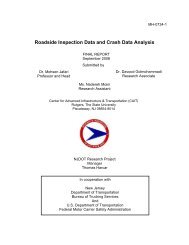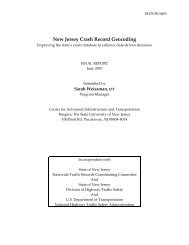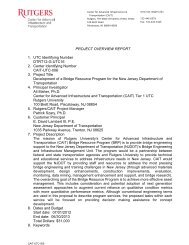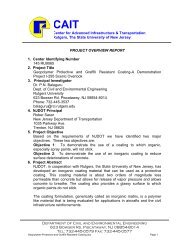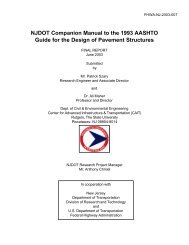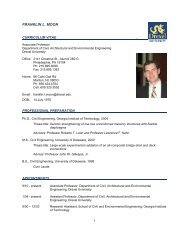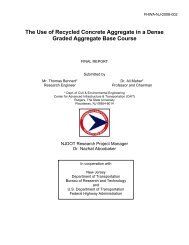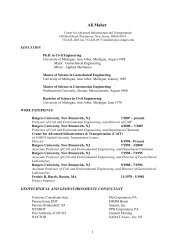Short Line Rail: Its Role in Intermodalism and Distribution
Short Line Rail: Its Role in Intermodalism and Distribution
Short Line Rail: Its Role in Intermodalism and Distribution
You also want an ePaper? Increase the reach of your titles
YUMPU automatically turns print PDFs into web optimized ePapers that Google loves.
Table 4.3: Commodity Flow Survey Shipments by Transportation Mode: 1993 <strong>and</strong><br />
2002<br />
(CFS Data Only)<br />
NOTE: The 2002 value data <strong>in</strong> this table are adjusted for <strong>in</strong>flation to allow comparison with the 1993 data. Also, these are CFS<br />
data only, therefore the numbers are different from those found <strong>in</strong> Table 4.2.<br />
KEY: — Represents data cell equal to zero or less than 1 unit of measure.<br />
S = Estimate does not meet publication st<strong>and</strong>ards because of high sampl<strong>in</strong>g variability or poor response quality.<br />
NA = Not applicable.<br />
1 “Truck” as a s<strong>in</strong>gle mode <strong>in</strong>cludes shipments that were made by only private truck, only for-hire truck, or a comb<strong>in</strong>ation of the two.<br />
2 CFS estimates for pipel<strong>in</strong>e exclude shipments of crude petroleum.<br />
3 Other multiple modes <strong>in</strong>clude comb<strong>in</strong>ation of truck <strong>and</strong> water, rail <strong>and</strong> water, <strong>and</strong> other comb<strong>in</strong>ations.<br />
SOURCE: U.S. DOT, 2006a. U.S. Department of Transportation, Research <strong>and</strong> Innovative Technology Adm<strong>in</strong>istration, Bureau of<br />
Transportation Statistics <strong>and</strong> U.S. Department of Commerce, U.S. Census Bureau, 2002 Commodity Flow Survey, U.S. Data,<br />
December 2004.<br />
Not surpris<strong>in</strong>gly, heavy, low-value commodities are mostly transported at lower unit<br />
costs by rail <strong>and</strong> water modes. Accord<strong>in</strong>g to composite estimates, rail shipments were<br />
valued at $198 per ton on average compared to $401 per ton for water <strong>and</strong> $775 per ton<br />
for truck <strong>in</strong> 2002. Multimodal comb<strong>in</strong>ation shipments were valued on average at<br />
approximately $4,892 per ton, while air-truck shipments averaged more than $88,618<br />
per ton. The variation <strong>in</strong> the modal averages is a reflection of the wide variation <strong>in</strong> the<br />
range of commodities moved by each of the modes. For example, trucks haul goods<br />
rang<strong>in</strong>g from gravel <strong>and</strong> crushed stones, coal, <strong>and</strong> gra<strong>in</strong> to electronic equipment,<br />
refrigerated perishables, pharmaceuticals, <strong>and</strong> gasol<strong>in</strong>e. <strong>Rail</strong> similarly hauls freight<br />
rang<strong>in</strong>g from low valued coal <strong>and</strong> other bulk commodities to higher valued products<br />
such as automobiles, petroleum <strong>and</strong> chemical products, etc. (U.S. DOT, 2006a).<br />
Accord<strong>in</strong>g to composite estimates, truck<strong>in</strong>g, as a s<strong>in</strong>gle mode, was used most<br />
frequently, account<strong>in</strong>g for an estimated 70 percent of the total value, 60 percent of the<br />
weight, <strong>and</strong> 34 percent of the ton-miles. 2 In 2002, the truck<strong>in</strong>g <strong>in</strong>dustry, both for-hire<br />
<strong>and</strong> private own-use, transported over $9 trillion worth of shipments, weigh<strong>in</strong>g over 11<br />
2 The relative modal shares of ton-miles depend on how “multi-modal” shipments are measured. <strong>Rail</strong> moves a slightly larger share<br />
when <strong>in</strong>termodal truck-rail shipments are counted <strong>in</strong> its totals.<br />
43



